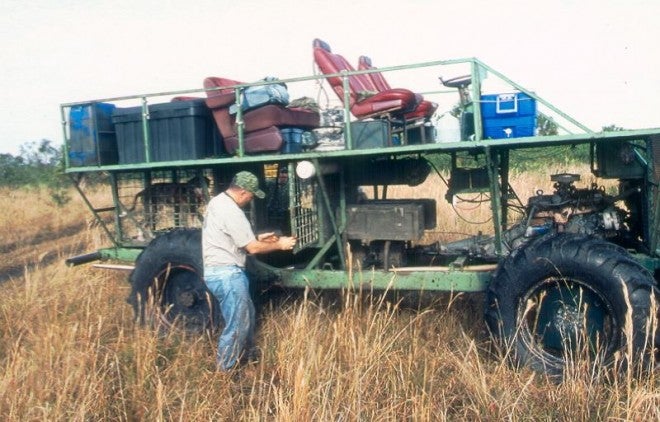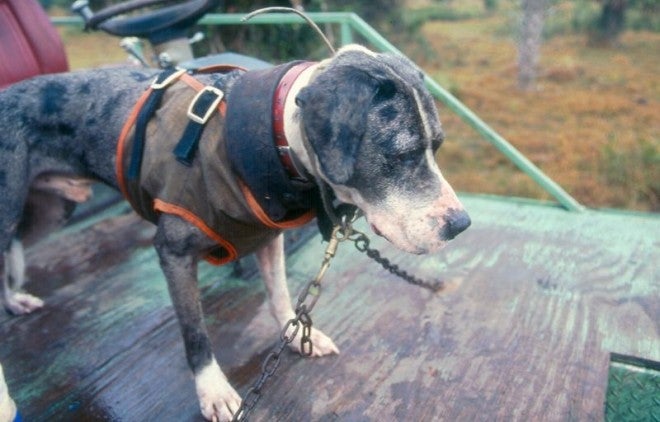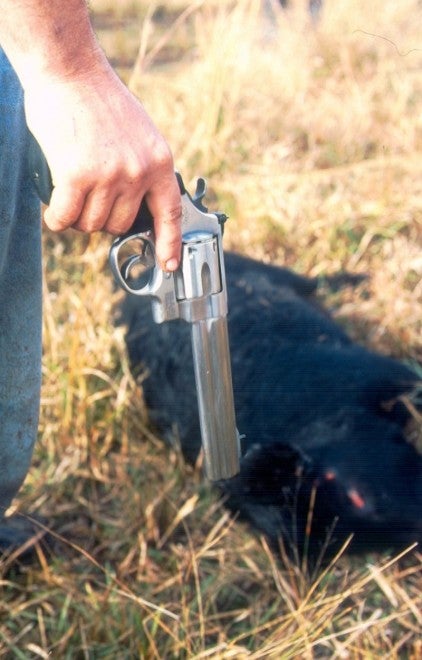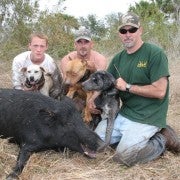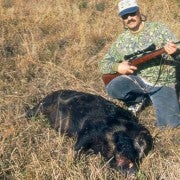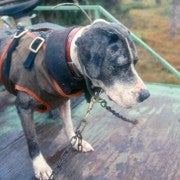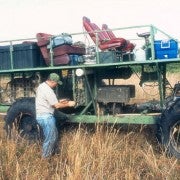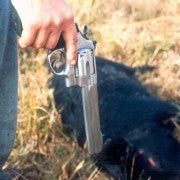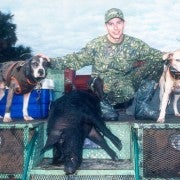Patrolling for porkers
Andy Hahn 07.22.13
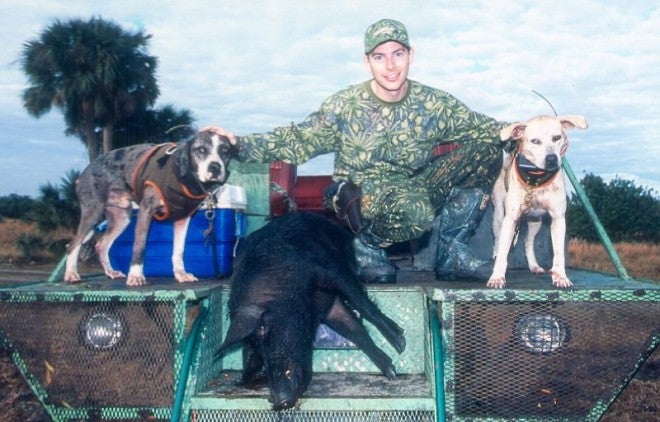
My baptism as a hog hunter took place in a waist-deep drainage ditch on a cattle ranch near Lake Okeechobee, Florida. Robert Paxton had just waded across the 10-foot-wide ditch. Soaked from boot heels to belt buckle, he looked back and matter-of-factly said, “At least one of you has to come help me. I can’t do this alone.”
Mike Tussey (owner of Osceola Outdoors guide service), fellow hunter Joel Townley, and I hemmed and hawed. Nobody felt eager to get wet at 7:30 on a January morning. The hound that had chased a hog across the ditch began barking more intensely. Paxton turned toward the sound coming through the palmetto scrub. He tightened his grip on the leash that held his second dog as it strained to join the action.
Tussey finally shifted the cell phone and wallet from his pants to a shirt pocket, and then slogged through the ditch. I figured I could either give up on the hunt and walk back to the motel to watch cartoons for the rest of the morning or jump feet first into the adventure that lay ahead. A minute later I scrambled up the far bank of the ditch with Townley following close behind. Water sloshed in our boots as we all took off at a trot to locate the dog-on-a-hog ruckus.
The baying dog kept barking in the pig’s face to command its attention and prevent escape. Paxton released the catch dog, which promptly grabbed the 120-pound sow by an ear and immobilized it. After a careful approach, Paxton lifted the hog wheelbarrow-style by the hind legs and deftly flipped the animal on its side. He quickly knelt on the pig’s ribs and neck, pinning it to the ground while Tussey pulled off the dogs.
“What do you think?” Paxton asked.
“It’s a long haul back to the buggy,” Tussey mused. “Better let her go.”
Townley and Tussey held the dogs while Paxton leapt up and scampered in our direction. The sow slowly got to her feet and eyed us. She started to charge but the snarling dogs persuaded her otherwise. The irate hog turned and bolted away, a survivor of catch-and-release hunting.
THE SWAMP THING
By the time we had crossed the ditch again and marched back to Paxton’s swamp buggy, strengthening daylight allowed me a better look at our mode of transportation. It seemed the perfect vehicle for cruising pond fringes and palmetto scrub in search of wild hogs—or for delivering Frankenstein’s bride to the wedding ceremony. Rather than robbing graves, however, Paxton visited the salvage yard to collect body parts while assembling his mechanical masterpiece.
The buggy’s organ donors include a Jeep Comanche (frame, rear axle), an International Scout (manual transmission), a Dodge Power Wagon (front axle) and a tractor (hydraulic steering components). Paxton procured the steering wheel from an unidentified Buick and added an aftermarket destroyer knob for a sure grip while traversing rough terrain.
The straight-six motor and automatic tranny came out of a 1979 Ford Fairmont. “The automatic transmission goes into a manual four-speed to reduce the gearing and produce more power. That way I don’t need a big engine,” Paxton says. Don’t bother looking for a rear view mirror or a brake pedal. Extremely low gearing makes brakes unnecessary; the buggy loses forward momentum the instant Paxton eases off the accelerator.
Riding on 149-24 tractor tires, the buggy’s top deck sits 6 feet above ground and measures 7 by 16 feet. The stable shooting platform offers ample room for hunters and gear. Under the deck you’ll find three dog pens and plenty of dry storage. “The 17-gallon tank holds enough fuel for me to run all day,” Paxton says. “And there are a few spots on the engine where I can warm up beanie-weenies if we want to have a hot lunch in the field.”
As we continued our search for porkers, Paxton explained how he, the dogs and the swamp buggy work together. “I like to use a somewhat smaller dog for baying,” he said, pointing to Daisy, a female Florida cur. “Her job is to find and stop a hog, barking constantly so we can locate them. Then we send in the catch dog, which holds the hog by an ear. And we’re right behind the catch dog.”
Sarge, a Catahoula leopard hound, performed catch duties on this hunt. Prior to setting out, Paxton had prepared the dogs for the day’s battle. He put radio-tracking transmitters as well as thick leather collars on both Daisy and Sarge to protect their necks. When he dressed Sarge in a heavy canvas vest to shield his ribs, the hound immediately tucked his tail between his legs. “He hates to wear the vest, but I’m starting to like this dog and I don’t want to see him get hurt,” Paxton joked.
Paxton plays the breeze by circling downwind of likely spots so the dogs can check for scent from the buggy’s elevated platform. If there’s little or no wind, he has to put the dogs on the ground and let them range ahead to cut a track. Once the dogs do their part, hunters can keep a safe distance and wait for a clear shot with a rifle or move in and take hogs in a very up-close-and-personal manner with a handgun or knife.\
THE HUNT HEATS UP
After an hour of prospecting, Daisy scented hogs. She dashed down the ladder, off the buggy and into the scrub. Paxton steered after her and we soon found ourselves in the middle of a palmetto thicket, able to hear but not see Daisy. Suddenly several black shapes erupted from the underbrush and barrelled past us. We were surrounded by pigs! A couple hogs stopped right beside the buggy but we didn’t shoot any because we wanted to let the dogs work them.
Daisy eventually bayed a 150-pound sow in an open area. Every time the hog tried to turn and run, Daisy got in front of it, barking in its face. Paxton released Sarge, and the catch dog grabbed the sow’s ear and pulled its head downward. With quick, practiced motions, Paxton then tackled and pinned the hog to the ground. He decided this one would make good eating and promptly dispatched it with a 4-inch pocket knife.
By the time we loaded the hog onto the buggy, Daisy was telling us she had another one bayed on the other side of a thick line of scrub. We mashed through and discovered the baying dog could also catch: She held a 10-pound piglet in her mouth. Tussey extracted the squealing porker from Daisy’s jaws, and when he put it on the ground the fierce little oinker charged him. He simply pushed the piglet away with his foot, but the angry midget kept coming back for a piece of him. After five charges, the tough guy let Tussey off easy and scampered toward the brush, still limping from Daisy’s bites.
While sweeping around a thicket, Daisy smelled hog and sprinted off to find the source. When we finally caught up to her, she was facing off with a 200-plus-pound boar in some sparse scrub at the edge of an open field. Paxton stopped the buggy 30 yards from the standoff, but instead of releasing Sarge, he asked who wanted to try a shot from there. Taking advantage of a perfect situation—the boar stood broadside, clearly visible, with Daisy a safe four feet in front of it—Townley rested his .30-06 on the buggy’s rail and dropped the hog with one shot to the head.
BRING THE KIDS
Two years after that exciting hunt, my mobility had become seriously impaired by the onset of ALS. I wanted to introduce my teenage nephews, Jason and Adam, to hunting, but I wasn’t able to handle the task alone. I knew just who to call.
We met Mike Tussey at one of his hunting leases on a Saturday afternoon so he could give the boys instruction on safe gun handling and let them do some target shooting with his .22 Hornet. The kids took an instant liking to the rural atmosphere, which was less than 100 miles, yet worlds away, from their urban, south Florida home. They also had fun driving the swamp buggy.
At dawn the next day our crew—Tussey, his friends Chris and Pat, my nephews, my wife and I, along with three hounds—boarded the swamp buggy. Stopping the vehicle at a cattle fence, Tussey asked Jason to open the gate. “I’ve tried to train the dogs to open and close gates, but it never works out,” Tussey joked. “That’s why I like to bring kids on these hunts.”
We quickly spotted five hogs trotting across a pasture but we couldn’t give chase because they were 500 yards away, on a neighboring farm and heading in the opposite direction. Things slowed down after that promising start; we went hours without rousting any pigs. Around noon, Chris shot a 300-pound boar that provided plenty of pork for our hunting party to divvy up.
Despite the scarcity of hogs on that day, Jason and Adam had a grand time. I realized that this kind of outing makes a perfect introduction to big game hunting for novices of any age. While beginners often feel bored if they have to remain still and quiet on a cold deer stand, the rolling swamp buggy offers several advantages: The constantly changing scenery keeps everyone engaged in scanning for hogs; silence isn’t necessary, so hunters can make comments and ask questions; movement is of no concern when stretching your legs or reaching in the cooler for snacks or soft drinks; the buggy allows disabled sportsmen to follow the hounds and participate actively in the hunt.
WHICH RIFLE?
Opinions vary when hog hunters discuss the best bore to use on boars. “I’ve never heard of game on the ground being too dead,” says Mark Davis of PRADCO Outdoors. “I like large calibers that shoot heavy bullets that will put hogs down. On any given hunt I may carry a .45-70, .30-06, .300 or 7mm mag. I also carry a .44 mag revolver.”
Davis practices shooting quite a bit and believes in careful shot placement, but he contends that big guns allow a certain margin of error while still ensuring a swift kill. “I lent my .45-70 to a friend and he took a 60-yard shot that entered near the jaw hinge of a 210-pound boar,” he says. “With a smaller caliber that shot might not have been fatal, but the .45 slug expanded enough to take out a good portion of the hog’s skull. It died immediately.”
Mike Tussey, of Osceola Outdoors, emphasizes shot placement more than bullet size, although he prefers lighter calibers. “I understand the big-bore fans who say that if a shot isn’t perfectly placed, a larger caliber still has knockdown power. That’s very true, but I often use a .223 or .22 Hornet. The key with a small-caliber gun is shooting hogs in the brain; aim just below the ear, or between the eye and ear,” he says. “My daughter has been taking hogs with a .22 Hornet since she was 10 years old. She uses a steady gun rest to hold the crosshairs on the hog’s ear, and it drops in its tracks. I tell my hunters to bring a rifle they can shoot accurately and feel comfortable with.”
When I asked Robert Paxton—a hound hunter who often goes one on one with the hogs his dogs catch—about his favorite gun, he smiled, patted his pocket and said, “Gun? I just use my pen knife!”
Link to slide show on YouTube: https://www.youtube.com/watch?v=q5dcUiDWTkA
